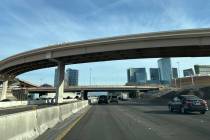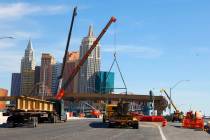Las Vegas listed among most dangerous for pedestrians, but …

A report titled “Dangerous by Design,” issued last week by the National Complete Streets Coalition, ranks Las Vegas the 13th most dangerous for pedestrians of 51 metropolitan areas in the United States.
Yes, it’s another of those “bad lists” we don’t want to be a part of, but the numbers don’t lie.
Or do they?
The list of dangerous cities is ranked by a “pedestrian danger index,” a calculation based on the rate of pedestrian deaths relative to the number of people who walk to work in the region. Las Vegas isn’t exactly a walk-to-work type of community, although valiant efforts are underway to make downtown a place where people can live and get to work without motorized transportation.
The coalition ranking doesn’t take into account the thousands of tourists who walk along our streets every day.
“We did not adjust for tourism in our numbers,” said the coalition’s report. “However, if a city sees significant numbers of visitors, it is in the city’s best interest to design streets to be safe for them.”
Based on the study’s data, Las Vegas has a worse pedestrian danger index than New York, Los Angeles and San Francisco. Yet on a separate list, those cities have the highest number of pedestrian deaths per 100,000 people from 2008 to 2012. On that list, Las Vegas ranked ninth (we’ve had 540 pedestrian deaths between 2003 and 2012), but my guess is that the city’s ranking would be much lower if tourist pedestrians were included in the calculation.
As far as the Complete Streets Coalition is concerned, it doesn’t matter whether the tourist numbers are added or not. The organization’s goal is to advocate safety features and the organization says other tourist communities have succeeded with that and have fewer traffic fatalities per capita than Las Vegas.
But before you conclude that the report isn’t worth the paper it’s printed on, consider the goals of the National Complete Streets Coalition and Smart Growth America, its sponsor organization.
Smart Growth America advocates changing the way roads are planned, designed and constructed. Complete Streets policies direct transportation planners and engineers to consistently plan and design streets with all users in mind.
What does a safe street look like? It has fewer and narrower traffic lanes, more medians, countdown signals on traffic lights and midblock crossings.
Southern Nevada transportation planners have bought into the concept and already are designing street projects that keep the pedestrian, the bicyclist and the mass transportation user in mind as well as the motorist (although some motorists disagree with the philosophy of reducing traffic lanes to provide wider sidewalks and bike paths).
Local municipalities also are buying in.
The city of Las Vegas is revamping Main Street as a one-way couplet pairing with Commerce Street. The $34 million project will offer wider sidewalks with curb extensions that will shorten street crossing distances on foot. Five-foot bicycle paths are in the plan.
Meanwhile, the Southern Nevada Strong planning coalition is in the midst of gathering public comment on a transportation plan for the 5-mile Maryland Parkway corridor.
The plan contains some controversial elements — reducing six lanes of traffic to four on a street that links downtown with McCarran International Airport via UNLV, a cluster of medical facilities and a major shopping mall. The two lanes being eliminated would provide room for mass transit down the center of the street, bike lanes and wider sidewalks.
It will be interesting to see how Complete Streets concepts are incorporated into a broad transportation plan emanating from the Las Vegas Convention Center campus. It’s too early to know how that would change the resort corridor’s look.
Another important aspect of the “Dangerous by Design” report is to point out that some in our population are worse off than others — which is why AARP participated in the study and advocates building safer streets. Older people accounted for one in five pedestrian fatalities nationwide. The top four dangerous cities are in Florida — Orlando, Tampa, Jacksonville and Miami — home to millions of retirees.
Because retirees also are flocking to Las Vegas and tourists often make bad decisions when walking the resort corridor, safer street designs are a worthy goal.
Questions and comments should be sent to roadwarrior@reviewjournal.com. Please include your phone number. Follow the Road Warrior on Twitter @RJroadwarrior.


















